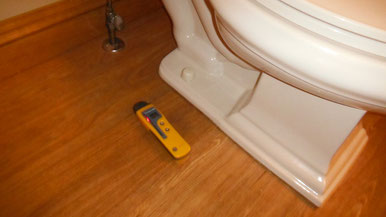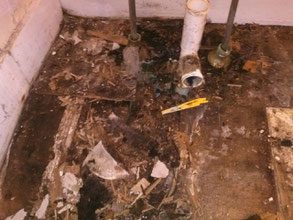The Helpful Home Inspector Blog
Helping You Better Understand Your Home
Inspection of Thrones - Spotting Common Toilet Issues

According to Prof. Google you will spend about three years of your life on the toilet. If you are like most of us, this time is usually spent in a higher order of thought, a chance to reflect on our lives and very existence. Surely you can spare just a few of those moments to look downward and make a quick check of the modern marvel that makes it all possible.
What we are looking for here are signs of leakage. While some of these issues may be obvious, others require just a bit of detective work. Even the smallest water loss can add up up quickly, giving you a double pain in the wallet. The water itself is not free, and repairs associated with moisture damage can be costly! Add to that the fact that moisture can contribute to conditions perfect for fungal growth, including mold, and you probably don't need too much more convincing that this is serious stuff. So, what do we look for?

- The first thing I do when inspecting a toilet is look for the obvious. Are there visible cracks in the bowl or tank? Is moisture evident on the floor around the stool? No? Let's keep looking.
- Flush the toilet. Does the toilet run constantly or intermittently, even when not flushed? Not only is this money down the drain, it can be indicitive of a leak. Additionally, if your home has a well, continuously running toilets can cause the well to run dry and the pump to burn out. That's bad.
- Check for loose connections. Here's how I do it: Close the lid and straddle the toilet, facing the wall. Grab the tank and give it a wiggle. It may give a bit, but not too much. Next, use the side of your leg to try and rock the toilet back and forth. It should be very firmly bolted down. If not, the wax seal will likely develop leaks.
- After your wiggle test, try reaching under the tank and feel the connection bolts for moisture that may be leaking due to a loose connection. Don't worry, you planned on washing your hands after this, right?
- You can test for slow leaks using a dye tablet placed in the top tank. Place the dye in the tank and wait for 15 minutes. Dye leaching into the bowl itself indicates a bad tank seal.
- If you are lucky enough to own a moisture meter such as the one pictured above (reliable ones are not cheap), check the under floor moisture levels surrounding the toilet. Invisible leaks due to a bad wax ring seal can be rotting out your subfloor and show no evidence on the surface.
- Gross. Wash your hands.
These quick checks will give you a good idea of whether or not you have any toilet issues. Pretty simple, really. A few minutes spent getting to know your toilet could save you money and heartache down the road, leaving your mind free to engage in more fulfilling bathroom reflection.
Crawlspace Insulation Installed.... But Upside Down

Here we have a crawlspace in a Pinckney, MI home. Put aside for a moment the obvious fact that the insulation is literally falling out of the joist cavities. The real defect here is that the insulation was installed improperly to begin with... upside down!
I know, at first look it would seem natural to face the nice, smooth, shiny kraft faced side toward the crawlspace. It just seems more 'finished'. Heck, they even give you handy little paper ears to make stapling a breeze. The itch factor seems lessened by installing it this way also.
Alas, it just isn't so: fiberglass batt insulation is designed for the paper side to face the heated space of the home. Kraft paper contains a special layer of asphalt adhesive. This acts as a vapor retarder, preventing water vapor from passing through.
In an upside down installation, where the paper faces the unheated portion of the home, moisture from the humid inside air can condense and become trapped inside of the insulation during cold winter months. This will likely result in fungal growth (mold) and rot.
If your crawlspace looks like this, fear not! It is one of the most common defects that I come across and can easily be fixed. If you decide to take it on yourself, don't forget an appoved respirator, gloves, and long sleeves. Fiberglass should not be inhaled and contact with skin can turn unpleasently itchy!
The Department of Energy has some pretty good resources if you'd like to find out more about insulating your home:
http://energy.gov/energysaver/articles/insulation
Call us Today To Schedule Your Home Inspection: (734) 749-4266
Connect With Us On Facebook




